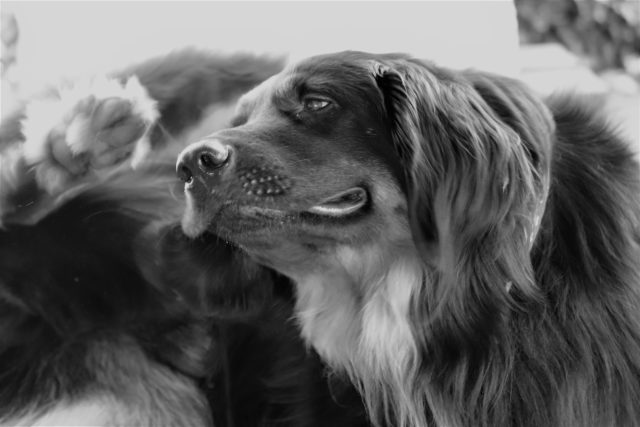
Itchiness (also referred to as pruritus) in dogs can be cause by several different things. All of us have the random, intermittent itch that merits scratching, but if the itch continues or comes along with hair loss or broken skin, this necessitates a visit to the doctor. With dogs, some of the reasons that would cause persistent itching could involve food and inhalant allergies, fungal, bacterial, or yeast infections, skin parasites, and disorders which are hormone related and lead the dog to become more prone to all of these. If an itch is scratched for a long duration of time, it becomes more likely that there will be some self-trauma and this can cause deep-seated or secondary infections that can be a challenge to resolve.
The number one cause of canine dermatitis is fleas. These pests are simple to identify and easy to eradicate. Fleas’ saliva is highly allergenic, creating a voracious itch. An infestation is frequently met with self-trauma, hair loss, and secondary skin infections. Fleas are also know to spread tapeworms. Topical products administered monthly with the purpose of killing and repelling fleas, flea eggs, and flea larvae are easily accessible.
The second most frequent cause of dogs’ itchiness is inhalant allergy (atopy). This can be problematic to expel, as the allergens travel through the air we breathe. Atopy is a primary and convoluting factor in several skin disorders. It generally reacts well to corticosteroids and antihistamines. Testing for allergies and desensitization serum injections are suggested in order to decrease the necessity of oral medications (as they may introduce negative side effects).
Sarcoptic mange (also known as scabies) is a microscopic mite which digs under the skin, creating a fierce itchiness. It can be difficult to detect on skin samples viewed under a microscope, however it does make itself known. Frequently, this is treated as a cause to rule out for itching before taking a look at other diagnostics. Injectable de-wormers are often utilized to eliminate scabies mites.
Ringworm is another cause; it is actually not a worm in any sense, it is a fungal infection of the skin. This condition can cause the hairs to break and leaves behind a red, scaly patch on the skin that will most likely itch. Some mild instances have found success with topical anti-fungal creams, however generalize infections typically necessitate the use of medicated shampoos or dips together with oral antifungal medications.
Yeast (Malassezia) infections of the skin are blatantly itchy. They also emit a foul, stale odor from the skin. Hyperpigmented and thickened skin (elephant skin) is a regular occurance in the appearance of dogs with Malassezia infections. In order to treat these infections, you should utilize anti-fungal shampoos and medications, as these are nearly always a secondary infection to some type of underlying disorder of the hormones or primary allergic dermatitis.








